
Commentarii de Bello Gallico, also Bellum Gallicum, is Julius Caesar's firsthand account of the Gallic Wars, written as a third-person narrative. In it Caesar describes the battles and intrigues that took place in the nine years he spent fighting the Celtic and Germanic peoples in Gaul that opposed Roman conquest.
Aulus Hirtius was consul of the Roman Republic in 43 BC and a writer on military subjects. He was killed during his consulship in battle against Mark Antony at the Battle of Mutina.
Gaius Volusenus Quadratus was a distinguished military officer of the Roman Republic. He served under Julius Caesar for ten years, during the Gallic Wars and the civil war of the 40s. Caesar praised him for his strategic sense and courageous integrity.

Commius was a king of the Belgic nation of the Atrebates, initially in Gaul, then in Britain, in the 1st century BC.

An evocatus was a soldier in the Ancient Roman army who had served out his time and obtained an honorable discharge but had voluntarily enlisted again at the invitation of the consul or other commander.
Bellum civile, or civil war in Latin, may refer to:

Commentarii de Bello Civili(Commentaries on the Civil War), or Bellum Civile, is an account written by Julius Caesar of his war against Gnaeus Pompeius and the Roman Senate. It consists of three books covering the events of 49–48 BC, from shortly before Caesar's invasion of Italy to Pompey's defeat at the Battle of Pharsalus and flight to Egypt. It was preceded by the much longer account of Caesar's campaigns in Gaul and was followed by similar works covering the ensuing wars against the remnants of Pompey's armies in Egypt, North Africa, and Spain. Caesar's authorship of the Commentarii de Bello Civili is not disputed, while the three later works are believed to have been written by contemporaries of Caesar.

De Bello Hispaniensi is a Latin work continuing Julius Caesar's commentaries, De Bello Gallico and De Bello Civili, and its sequels by two different unknown authors De Bello Alexandrino and De Bello Africo. It details Caesar's campaigns on the Iberian Peninsula, ending with the Battle of Munda.
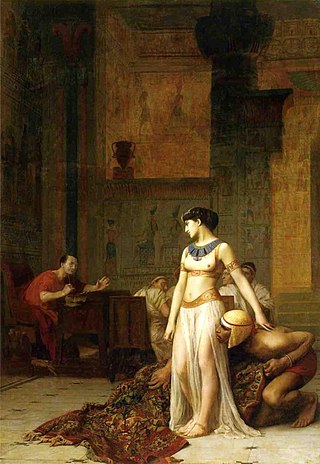
De Bello Alexandrino is a Latin work continuing Julius Caesar's commentaries, De Bello Gallico and De Bello Civili. It details Caesar's campaigns in Alexandria and Asia.
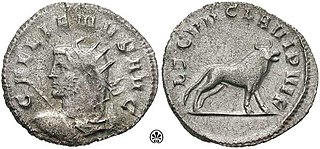
Titus Terrasidius was a Roman Knight of the Equestrian order and an officer of the cavalry in Julius Caesar's Legio VII Claudia. He and other officers of the legion were sent out to negotiate provisions for the winter of 56–55 BC; they were captured by Breton tribes who were then subjugated as Caesar describes in his Commentarii de Bello Gallico:
The occasion of that war was this: Publius Crassus, a young man, had taken up his winter-quarters with the seventh legion among the Andes, who border upon the Ocean. He, as there was a scarcity of corn in those parts, sent out some officers of cavalry [who would be equites], and several military tribunes [who would be of senatorial rank] among the neighbouring states, for the purpose of procuring corn and provision; in which number Titus Terrasidius was sent among the Esubii; Marcus Trebius Gallus among the Curiosolitae; Quintus Velanius, [and] Titus Silius, amongst the Veneti.
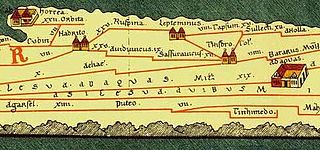
Leptis or Lepcis Parva was a Phoenician colony and Carthaginian and Roman port on Africa's Mediterranean coast, corresponding to the modern town Lemta, just south of Monastir, Tunisia. In antiquity, it was one of the wealthiest cities in the region.
Roman historiography stretches back to at least the 3rd century BC and was indebted to earlier Greek historiography. The Romans relied on previous models in the Greek tradition such as the works of Herodotus and Thucydides. Roman historiographical forms are usually different from their Greek counterparts, however, and often emphasize Roman concerns. The Roman style of history was based on the way that the Annals of the Pontifex Maximus, or the Annales Maximi, were recorded. The Annales Maximi include a wide array of information, including religious documents, names of consuls, deaths of priests, and various disasters throughout history. Also part of the Annales Maximi are the White Tablets, or the "Tabulae Albatae", which consist of information on the origin of the Roman Republic.

The gens Considia was a plebeian family at ancient Rome. The Considii came to prominence in the last century of the Republic, and under the early Empire, but none of them rose any higher than the praetorship.

Aggar was a town and bishopric in the Roman province of Byzacena. One of two cities in the area, it left vast ruins that are now called (Henchir) Sidi Amara. These edifices are situated in the plain of Siliana, around 60 kilometres east of Maktar.
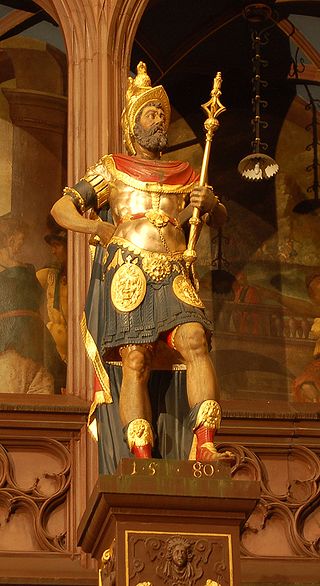
The gens Munatia was a plebeian family at Rome. Members of this gens are first mentioned during the second century BC, but they did not obtain any of the higher offices of the Roman state until imperial times.
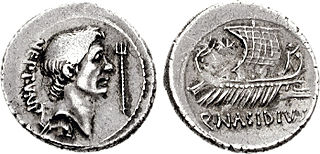
The gens Nasidia was an obscure plebeian family at Rome. The gens is best known from Quintus Nasidius, one of the admirals of Gnaeus Pompeius Magnus during the Civil War. Although none of the Nasidii are known to have held any of the higher offices of the Roman state, a number are known from inscriptions. A coin of this gens depicts the head of Pompeius and a trident on the obverse, and on the reverse a ship, with the inscription Q. Nasidius.
The gens Pedia was a plebeian family at ancient Rome. Members of this gens are first mentioned in history during the final century of the Republic, and for the next two centuries they were distinguished in statesmanship, rhetoric, art, and law. The first of the Pedii to obtain the consulship was Quintus Pedius, the nephew of Caesar, in 43 BC.
The gens Petreia was a minor plebeian family at ancient Rome. Members of this gens are first mentioned toward the end of the second century BC, and several were distinguished as soldiers, but none of them ever attained the consulship.

Lucius Vorenus and Titus Pullo were two Roman centurions mentioned in the personal writings of Julius Caesar. Although it is sometimes stated they were members of the 11th Legion, Caesar never states the number of the legion concerned, giving only the words in ea legione. All that is known is that the legion in which they served under Caesar was one commanded at the time by Quintus Cicero.
Quintus Nasidius, sometimes referred to as Lucius Nasidius, was a Roman naval commander who lived during the 1st century BC and sided with the Optimates during Caesar's Civil War.












